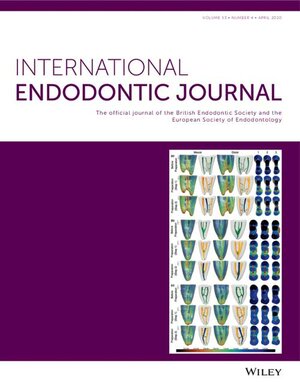A novel artificial intelligence-powered tool for automated root canal segmentation in single-rooted teeth on cone-beam computed tomography
Abstract
Aim
To develop and validate an artificial intelligence (AI)-powered tool based on convolutional neural network (CNN) for automatic segmentation of root canals in single-rooted teeth using cone-beam computed tomography (CBCT).
Methodology
A total of 69 CBCT scans were retrospectively recruited from a hospital database and acquired from two devices with varying protocols. These scans were randomly assigned to the training (n = 31, 88 teeth), validation (n = 8, 15 teeth) and testing (n = 30, 120 teeth) sets. For the training and validation data sets, each CBCT scan was imported to the Virtual Patient Creator platform, where manual segmentation of root canals was performed by two operators, establishing the ground truth. Subsequently, the AI model was tested on 30 CBCT scans (120 teeth), and the AI-generated three-dimensional (3D) virtual models were exported in standard triangle language (STL) format. Importantly, the testing data set encompassed different types of single-rooted teeth. An experienced operator evaluated the automated segmentation, and manual refinements were made to create refined 3D models (R-AI). The AI and R-AI models were compared for performance evaluation. Additionally, 30% of the testing sample was manually segmented at two different times to compare AI-based and human segmentation methods. The time taken by each segmentation method to obtain 3D models was recorded in seconds(s) for further comparison.
Results
The AI-driven tool demonstrated highly accurate segmentation of single-rooted teeth (Dice similarity coefficient [DSC] ranging from 89% to 93%; 95% Hausdorff distance [HD] ranging from 0.10 to 0.13 mm), with no significant impact of tooth type on accuracy metrics (p > .05). The AI approach outperformed the manual method (p < .05), showing higher DSC and lower 95% HD values. In terms of time efficiency, manual segmentation required significantly more time (2262.4 ± 679.1 s) compared to R-AI (94 ± 64.7 s) and AI (41.8 ± 12.2 s) methods (p < .05), representing a 54-fold decrease.
Conclusions
The novel AI-based tool exhibited highly accurate and time-efficient performance in the automatic root canal segmentation on CBCT, surpassing the human performance.


 求助内容:
求助内容: 应助结果提醒方式:
应助结果提醒方式:


